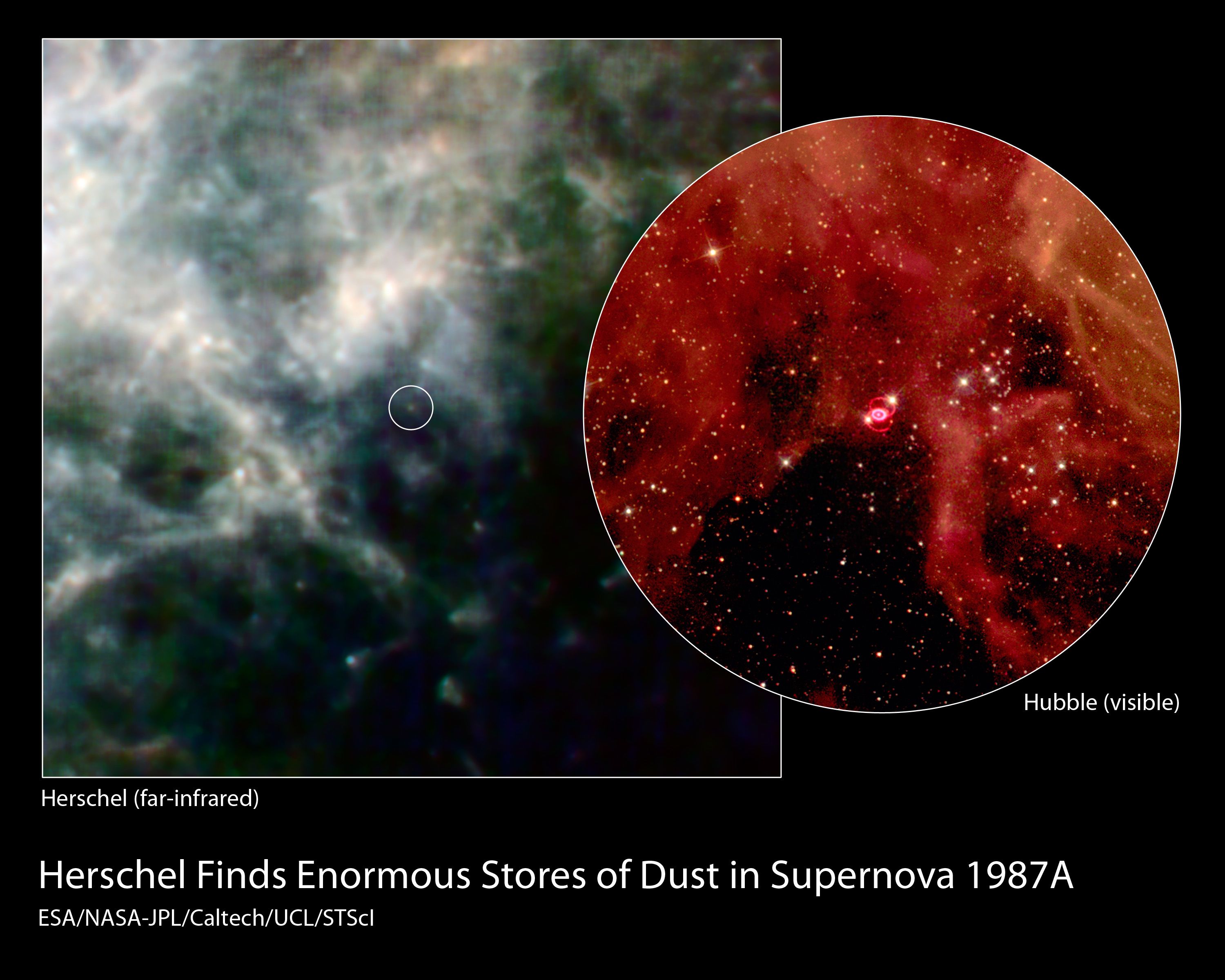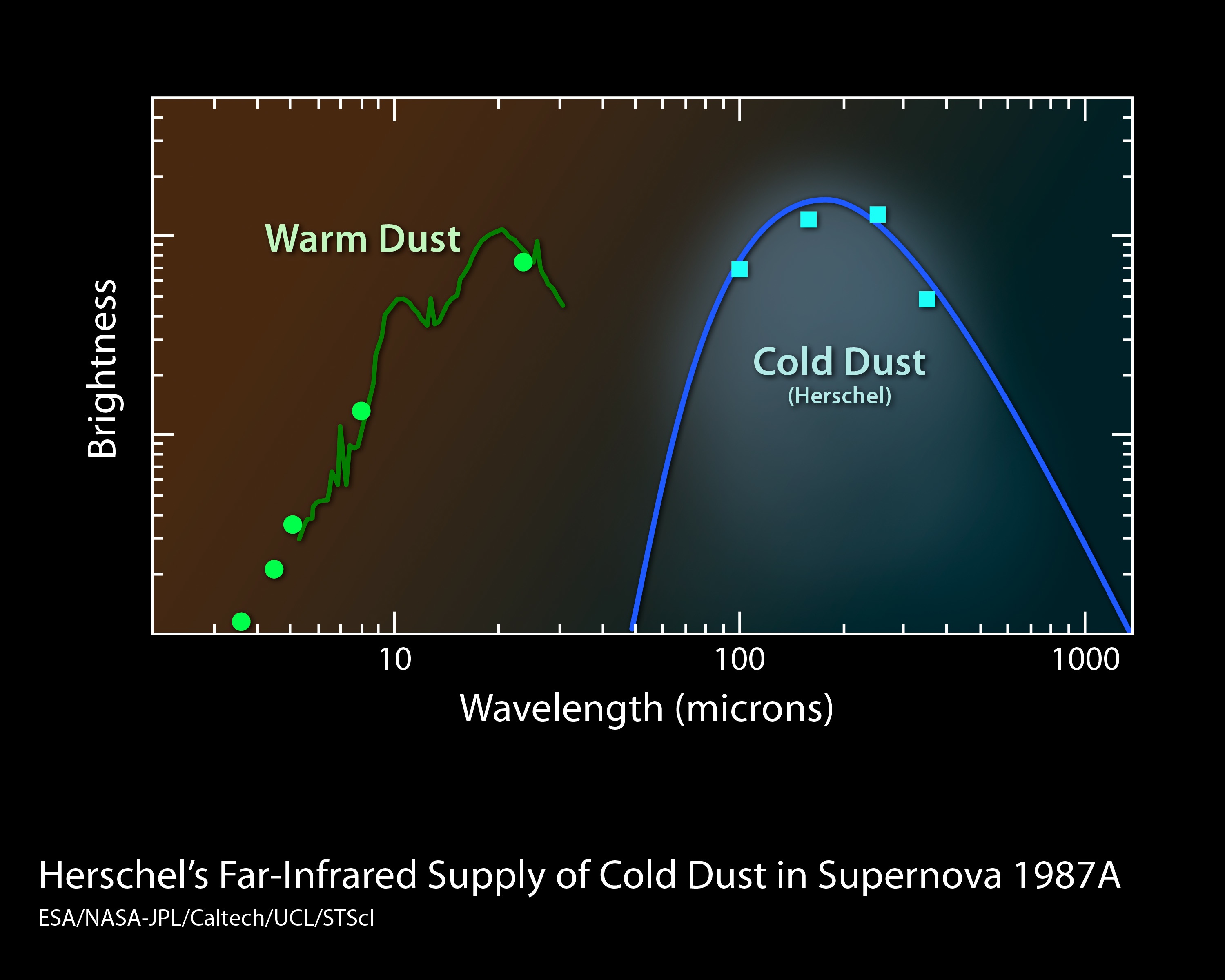August 25, 2010
Institute for the Physics and Mathematics of the Universe (IPMU)
An international research group composed of Mikako Matsuura in University College of London, Takaya Nozawa in the Institute for Physics and Mathematics of the Universe (IPMU), and their collaborators observed SN 1987A in the Large Megellanic Cloud with the Herschel Space Observatory. They found that extremely cold dust grains of temperatures lower than -250 Celsius are shining in SN 1987A with 200 times the energy of the Sun. The corresponding mass of the dust is more than 200,000 of the Earth mass, indicating that SN 1987A produced a large amount of dust at the explosion. So far, the origin of cosmic dust has been one of the big mysteries in astronomy, but this discovery demonstrates that supernovae are main sources of dust in the universe. This result provides key clues in understanding the evolution of the solid materials throughout the cosmic age, as well as the origin of the Earth on which we live.
Publication: Science 2011 September 2 issue
Title: Herschel Detects a Massive Dust Reservoir in Supernovae 1987A
Authors: Mikako Matsuura, Eli Dwek, Margaret Meixner
CONTACTS
For more details
IPMU Post Doctoral Researcher e-mail. takaya.nozawa _at_ ipmu.jp |
Media Contact
IPMU Press Officer e-mail. press _at_ ipmu.jp |
SUMMARY
Cosmic dust grains, which are solid materials with sizes smaller than 1 µm, are universally present in the interstellar space. Since dust grains absorb ultraviolet and optical photons and emit them as infrared radiation, they have serious impacts on the observations of stars and galaxies. In addition, dust grains are the raw materials for rocky planets like the Earth, and ultimately, life itself, so the investigation of their origin and evolution is indispensible for answering the question of why we exist on the Earth.
In particular, recent observations towards the distant universe discovered that huge amounts of dust had already existed at early times when the cosmic age was less than one tenth of the present cosmic age (13.7 billion years). So the question is “How were such massive dust grains made in the early universe?” Dust grains are composed of heavy elements such as carbon, oxygen, silicon, and iron, all of which were not produced in the Big Bang. Heavy elements are synthesized inside stars and are ejected to the interstellar space during very late phases of stellar evolution. However, the lifetimes of Sun-like stars are so long that they cannot supply heavy elements and dust grains in such early epochs. Therefore, supernovae, which are explosions of short-lived massive stars with more than 10 times the mass of the Sun, have been considered to be major sources of dust in the early universe.
This hypothesis was proved for the first time by the observation of SN 1987A with the Herschel Space Observatory. SN 1987A is a stellar explosion that occurred from a star with around 20 times the mass of the Sun on 23rd February 1987 in the Large Magellanic Cloud 164,000 light years away from us. SN 1987A is a very famous object because it is the first supernova from which cosmic neutrinos were detected, whose achievement awarded Emeritus Professor Masatoshi Koshiba at the University of Tokyo the Novel Prize in Physics in 2002. SN 1987A is the closest supernova to be witnessed with the naked eye from Earth in the past 400 years and has been providing astronomers with good opportunities to study physical processes of an exploding star.
Herschel Space Observatory is a far-infrared to submillimeter Telescope launched by the European Space Agency (ESA) on 14th May 2009. At far-infrared to submillimeter wavelengths, we can see the emission from extremely cold dust in the interstellar space. While the research group was surveying the Large Magellanic Cloud with the Herschel Space Observatory, they discovered at a position of SN 1987A a strong far-infrared source emitting 200 times the energy of the Sun (Figure 1). From the brightness and energy distribution (Figure 2), they recognized that the temperature of the emitting dust is lower than -250 Celsius, and that the amount of the dust is more than 200,000 of the Earth mass.
This estimated mass of dust in SN 1987A is more than 1,000 times higher than the previous estimates in other supernovae and is massive enough to explain a large quantity of dust in the early universe if similar amounts of dust are formed in all such explosions. This discovery was only achieved by seeing cold dust at far-infrared wavelengths observed by Herschel. This Herschel observation provides the best evidence yet that violent stellar explosions are efficient dust-making factories in the universe, indicating that the Earth on which we stand is made almost entirely of dust produced in supernovae. Twenty four years after the initial explosion, SN 1987A gave us another new wisdom about the origin of cosmic dust.
FIGURE 1
|
Left image: a far-infrared picture taken by the Herschel Space Observatory. Right image: an enlarged view of the circled region at the left image, taken with the Hubble Space Telescope. The tiny pink ring in the Hubble optical image shows where a blast wave of SN 1987A is hitting the surrounding materials expelled from the star before the explosion. The cause for the two outer, faint rings is unknown. * Image credit: ESA/NASA-JPL/UCL/STScl |
 |
FIGURE 2
|
Infrared spectral energy distribution of SN 1987A. The mid-infrared data (green, at wavelengths from 3 µm to 30 µm) obtained with the Spitzer Space Telescope represent the emission from warm dust in the ring surrounding SN 1987A. This dust formed before the explosion and is now being heated up by the impact with the blast wave of the supernova. In contrast, the far-infrared data (blue, at wavelengths from 100 µm to 350 µm) obtained with the Herschel Space Observatory represent the emission from cold dust newly formed in the expanding ejecta after the explosion. * Image credit: ESA/NASA-JPL/UCL/STScl |
 |
RESEARCH GROUP
M. Matsuura (UCL), E. Dwek (NASA GSFC), M. Meixner (STSI), M. Otsuka (STSI), B. Babler (U. Wisconsin), M. J. Barlow (UCL), J. Roman-Duval (STSI), C. Engelbracht (U. Arizona), K. Sandstrom (MPIA), M. Lakicevic (Keel U./ESO), J. Th. Van Loon (Keel U.), G. Sonneborn (NASA GSFC), G. C. Clayton (LSU), K. S. Long (STSI), P. Lundqvist (Stockholm), T. Nozawa (IPMU), K. D. Gordon (STSI), S. Hony (CEA), P. Panuzzo (CEA), K. Okumura (CEA), K. A. Misselt (U. Arizona), E. Montiel (U. Arizona), M. Sauvage (CEA)
REFERENCES






